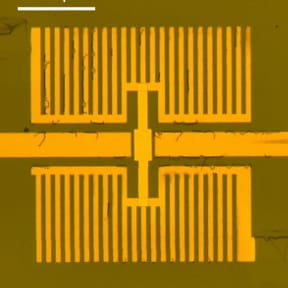The unique electronic properties of graphene can be harnessed in a sensor that could be used for highly sensitive security screening to detect explosives and other hazardous substances, according to research from the Cambridge Graphene Centre. Combining the single-atom-thick carbon with pyroelectric materials, which generate electric fields when heated or cooled, the team has produced a sensor that can detect temperature changes down to a few tens of µK.
The research was part of a European consortium known as the Graphene flagship, which aims to commercialise graphene applications within 10 years. In a paper in Nature Communications, the team describes devices based on pyroelectric substrates onto which a graphene layer is deposited. On top of this is placed a type of electrode known as a ‘floating gate’, which concentrates the temperature change-induced electric field produced by the substrate onto the graphene. This changes the electrical resistance of the material, which is measured as the device output. Devices that measure changes in resistance due to heating are known as bolometers, and the team claims that the combination of pyroelectricity and bolometer activity means that these sensors could be used as pixels in a high-resolution thermal imaging camera.

One particular advantage of using graphene in this system is that it acts as a built-in amplifier for the pyroelectric signal from the substrate, so there is no need for extra transistor-based amplifiers which need to be used in conventional infrared sensors. These amplifiers tend to introduce losses and noise in the sensor circuits, which reduces their sensitivity. “We can build the amplifier directly on the pyroelectric material. So, all the charge that it develops goes to the amplifier. There is nothing lost along the way,” said Dr Alan Colli, co-author of the work, who is from Emberion, a company spun out from Nokia last year to develop x-ray, thermal and infrared camera sensors and a partner in the research, along with Nokia.
The electrical conductivity of the graphene also helps with integrating the sensor with the external readout integrated circuit, Colli added, ensuring that the sensor signal is transmitted as efficiently as possible.
The temperature change detected by the sensor is around 1000 times smaller than that induced by a human hand placed in close proximity, which is the highest reported temperature sensitivity for graphene-based uncooled thermal detectors. This sensitivity means that the sensor can be used for spectroscopy, detecting the narrow bands of the infrared spectrum that are absorbed or emitted by specific chemical groups; conventional IR detectors are not sensitive enough for this.
“With a higher sensitivity detector, you can restrict the band and still form an image just by using photons in a very narrow spectral range, and you can do multi-spectral IR imaging. For security screening, there are specific signatures that materials emit or absorb in narrow bands. So, you want a detector that’s trained in that narrow band. This can be useful while looking for explosives, hazardous substances, or anything of the sort,” explained Colli. Moreover, the detectors can operate in a spectroscopic mode at room temperature, with no need to expose objects being studied to extra heat.





Red Bull makes hydrogen fuel cell play with AVL
Formula 1 is an anachronistic anomaly where its only cutting edge is in engine development. The rules prohibit any real innovation and there would be...